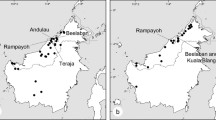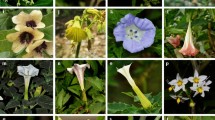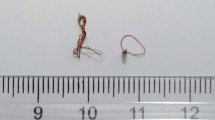Abstract
Morphological and floral chemical components are both important cues used by plants to attract pollinators. Two local ecotypes named ‘Nabawan’ and ‘Apin-Apin’ produced by the tropical orchid, Bulbophyllum ecornutum subspecies verrucatum, exhibit different morphology and scents to attract males of certain Bactrocera and Zeugodacus fruit fly species in the tribe Dacini as potential pollinators. Flowers of the Nabawan-ecotype possess a narrow-shaped lip (= labellum) structure and emit a characteristic fragrance of raspberry ketone along with smaller amounts of rhododendrol, whereas those of Apin-Apin-ecotype possess a broad-shaped lip and emit zingerone and zingerol as major components. Nevertheless, the structure of stiff hamulus appears similar and acts as a ‘crowbar’ during pollinarium removal by a fruit fly, indicating the basic mechanics of the movable see-saw lip structure to trap a fly is essentially the same. The changes in both morphology and chemistry, despite no significant difference in chloroplast DNA sequences, shown by the two ecotypes, might have occurred as part of a coevolutionary process involving both the Dacini fruit fly pollinators and the Bulbophyllum orchids in their natural habitats.





Similar content being viewed by others
References
Ayasse M, Gögler J, Stökl J (2010) Pollinator-driven speciation in sexually deceptive orchids of the genus Ophrys. In: Glaubrecht M (ed) Evolution in action. Springer, Berlin-Heidelberg, pp 101–118
Ayasse M, Stökl J, Francke W (2011) Chemical ecology and pollinator-driven speciation in sexually deceptive orchids. Phytochemistry 72:1667–1677
Christenson EA, Whitten MW (1995) Phalaenopsis bellina (Rchb.f.) Christenson, a segregate from P. violacea Witte (Orchidaceae: Aeridinae). Brittonia 47:57–60
Clarke AR, Balagawi S, Clifford B, Drew RAI, Leblanc L, Mararuai A, McGuire D, Putulan D, Sar SA, Tenakanai D (2002) Evidence of orchid visitation by Bactrocera species (Diptera: Tephritidae) in Papua New Guinea. J Trop Ecol 18:441–448
Dormont L, Joffard N, Schatz B (2019) Intraspecific variation in floral color and odor in orchids. Int J Plant Sci 180:1036–1058
Dressler RL (1981) The orchids. Natural history and classification. Harvard University Press, Oxford
Fay HAC (2011) A highly effective and selective male lure for Bactrocera jarvisi (Tryon) (Diptera: Tephritidae). Austr Entomol 51:189–197
Harder LD, Johnson SD (2008) Function and evolution of aggregated pollen in angiosperms. Int J Plant Sci 169:59–78
Howcroft NHS (1983) Contributions to the orchid flora of the Araucaria forests in New Guinea - 5 Bulbophyllum gjellerupii J.J. Smith. Orchadian 7:230–231
Hsiao YY, Tsai WC, Kuoh CS, Huang TH, Wang HC, Wu TS, Leu YL, Chen WH, Chen HH (2006) Comparison of transcripts in Phalaenopsis bellina and Phalaenopsis equestris (Orchidaceae) flowers to deduce monoterpene biosynthesis pathway. BMC Plant Biol 6:14
Humeau L, Micheneau C, Jaquemyn H, Gauvin-Bialecki A, Fournel J, Pailler T (2011) Sapromyiophily in the native orchid, Bulbophyllum variegatum, on Reunion (Mascarene Archipelago, Indian Ocean). J Trop Ecol 27:591–599
Kaiser R (1993) The scent of orchids—olfactory and chemical investigations. Elsevier, Amsterdam
Katte T, Tan KH, Su ZH, Ono H, Nishida R (2020) Floral fragrances in two closely related fruit fly orchids, Bulbophyllum hortorum and B. macranthoides (Orchidaceae): assortments of phenylbutanoids to attract tephritid fruit fly males. Appl Entomol Zool 55:55–64
Khoo CCH, Tan KH (2000) Attraction of both sexes of melon fly, Bactrocera cucurbitae to conspecific males—a comparison after pharmacophagy of cue-lure and a new attractant—zingerone. Entomol Exp Appl 97:317–320
Nakahira M, Ono H, Wee SL, Tan KH, Nishida R (2018) Floral synomone diversification of Bulbophyllum sibling species (Orchidaceae) in attracting fruit fly pollinators. Biochem Syst Ecol 81:86–95
Nilsson LA (1992) Orchid pollination biology. Trend Ecol Evol 7:255–259
Nishida R (2014) Chemical ecology of insect-plant interactions: ecological significance of plant secondary metabolites. Biosci Biotech Biochem 78:1–13
Nishida R, Iwahashi O, Tan KH (1993) Accumulation of Dendrobium (Orchidaceae) flower fragrance in the rectal glands by males of the melon fly, Dacus cucurbitae (Tephritidae). J Chem Ecol 19:713–722
Nishida R, Tan KH, Wee SL, Hee AKW, Toong YC (2004) Phenylpropanoids in the fragrance of the fruit fly orchid, Bulbophyllum cheiri, and their relationship to the pollinator, Bactrocera papayae. Biochem Syst Ecol 32:245–252
Ong PT, Tan KH (2011) Fly pollination in four Malaysian species of Bulbophyllum (Section Sestochilus)—B. lasianthum, B. lobbi, B. subumbellatum and B. virescens. Malesian Orchid J 8:103–110
Ong PT, Hee AKW, Wee SL, Tan KH (2011) The attraction of flowers of Bulbophyllum section Sestochilus to Bactrocera fruit flies (Diptera: Tephritidae). Malesian Orchid J 8:93–102
Paulus HF (2006) Deceived males—pollination biology of the Mediterranean orchid genus Ophrys (Orchidaceae). J Eur Orchids 38:303–353
Rasmussen FN (1985) The gynostemium of Bulbophyllum ecornutum (J. J. Smith) J. J. Smith (Orchidaceae). Bot J Linn Soc 91:447–456
Ridley HN (1890) On the method of fertilization in Bulbophyllum macranthum, and allied orchids. Ann Bot 4:327–336
Royer JE (2015) Responses of fruit flies (Tephritidae: Dacinae) to novel male attractants in north Queensland, Australia, and improved lures for some pest species. Austral Entomol 54:411–426
Royer JE, Tan KH, Mayer DG (2020) Comparative trap catches of male Bactrocera, Dacus, and Zeugodacus fruit flies (Diptera: Tephritidae) with four floral phenylbutanoid lures (anisyl acetone, cue-lure, raspberry ketone and zingerone) in Queensland, Australia. Environ Entomol 49:815–822
Symthe R (1969) An observation on the pollination of Bulbophyllum baileyi. Orchadian 3:61
Taberlet P, Giell L, Pauto UG, Bouvet J (1991) Universal primers for amplification of three non-coding regions of chloroplast DNA. Plant Mol Biol 17:1105–1109
Tan KH, Nishida R (1998) Ecological significance of a male attractant in the defence and mating strategies of the fruit fly pest, Bactrocera papayae. Entomol Exp Appl 89:155–158
Tan KH, Nishida R (2000) Mutual reproductive benefits between a wild orchid, Bulbophyllum patens, and Bactrocera fruit flies via a floral synomone. J Chem Ecol 26:533–546
Tan KH, Nishida R (2005) Synomone or kairomone? – Bulbophyllum apertum flower releases raspberry ketone to attract Bactrocera fruit flies. J Chem Ecol 31:497–507
Tan KH, Nishida R (2007) Zingerone in floral synomone of Bulbophyllum baileyi (Orchidaceae) attracts Bactrocera fruit fly during pollination. Biochem Syst Ecol 35:334–341
Tan KH, Nishida R (2013) Pollination of bactrocerophilous Bulbophyllum orchids. In: Elliott J, Kurzweil HF, O’Byrne P, Tan KW, van der Schans AS, Wong SM, Yam TM (eds) Proc 20th World Orchid Conference. Singapore Botanic Gardens, Singapore, pp 273–279
Tan KH, Tan LT (2018) Movements of floral parts and roles of the tooth on the column wall of Bulbophyllum praetervisum (Orchidaceae) flower in pollination by Dacini fruit flies (Diptera: Tephritidae). J Poll Ecol 24:157–163
Tan KH, Nishida R, Toong YC (2002) Floral synomone of a wild orchid, Bulbophyllum cheiri, lures Bactrocera fruit flies for pollination. J Chem Ecol 28:1161–1172
Tan KH, Tan LT, Nishida R (2006) Floral phenylpropanoid cocktail and architecture of Bulbophyllum vinaceum orchid in attracting fruit flies for pollination. J Chem Ecol 32:2429–2441
Tan KH, Nishida R, Jang EB, Shelly TE (2014) Pheromones, male lures, and trapping of tephritid fruit flies. In: Shelly TE, Epsky N, Jang EB, Reyes-Flores J, Vargas RI (eds) Trapping and the detection, control, and regulation of tephritid fruit flies. Springer, Netherlands, pp 15–74
Tremblay RL (1992) Trends in the pollination ecology of the Orchidaceae: evolution and systematics. Canad J Bot 70:642–650
Van der Pijl L, Dodson CH (1969) Orchid flowers: their pollination and evolution. University of Miami Press, Miami
Van der Niet T, Jürgen SA, Johnson SD (2010) Pollinators, floral morphology and scent chemistry in the southern African orchid genus Schizochilus. S Afr J Bot 76:726–738
Vermeulen JJ (1991) Orchids of Borneo. Vol. 2—Bulbophyllum. Bentham-Moxon Trust, Toihaan Publishing Co. and The Sabah Society, Kota Kinabalu
Vermeulen JJ, O’Byrne P, Lamb A (2015) Bulbophyllum of Borneo. Natural History Publications, Borneo
Waser NM, Chittka L, Price MV, Williams NM, Ollerton J (1996) Generalization in pollination systems, and why it matters. Ecology 77:1043–1060
Wee SL, Peek T, Clarke AR (2018) The responsiveness of Bactrocera jarvisi (Diptera: Tephritidae) to two naturally occurring phenylbutanoids, zingerone and raspberry ketone. J Insect Physiol 109:41–46
Xu SQ, Schlüter PM, Schiestl FP (2012) Pollinator-driven speciation in sexually deceptive orchids. Int J Ecol 2012:1–9
Acknowledgements
We wish to express our sincere appreciation to the Manager of the Orchid Centre, Department of Agriculture, Tenom, Sabah, for the supply of orchid flowers; and to Prof D. Haymer, University of Hawaii at Manoa, for his critical comments on this manuscript. This work was partly supported by the Grant-in-Aid for Scientific Research from JSPS (No. 15405022 and 19310142 to RN; No. 26450466 to HO).
Author information
Authors and Affiliations
Corresponding author
Additional information
Handling Editor: Anna-Karin Borg-Karlson.
Publisher's Note
Springer Nature remains neutral with regard to jurisdictional claims in published maps and institutional affiliations.
Rights and permissions
About this article
Cite this article
Tan, KH., Vermeulen, J.J., Katte, T. et al. Diversification in both the floral morphology and chemistry in two daciniphilous orchid ecotypes in Borneo. Arthropod-Plant Interactions 15, 447–455 (2021). https://doi.org/10.1007/s11829-021-09821-9
Received:
Accepted:
Published:
Issue Date:
DOI: https://doi.org/10.1007/s11829-021-09821-9




